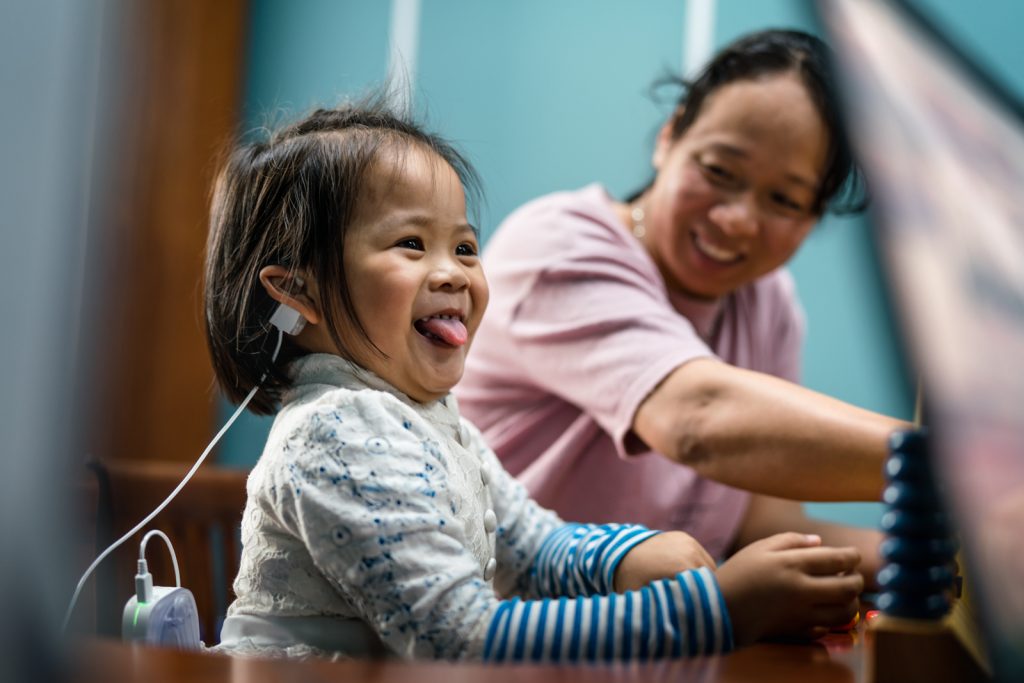
The camera captures the joyous moment as a young girl is able to hear for the first time. Titled ‘Ha’s moment of lift: Hearing for the first time’, the image is in firstplace of five winning entries to FOCUS: Philanthropy, a Europe-wide photo contest organised by DAFNE that tells visual stories of the people behind philanthropy and how they work for a better Europe. Ha is one of ten children from Vietnam who were provided with cochlear implants and audio-verbal therapy by the Swiss Hear the World Foundation in partnership with the Global Foundation for Children with Hearing loss. Alliance magazine speaks to Elena Torresani of Hear the World Foundation to find out the story behind the photo.
What inspired you to get involved with FOCUS: Philanthropy?
When Sonova, the leading provider of hearing systems, founded the Hear the World Foundation in 2006, the aim was to live up to its social responsibility to help the most needy, especially children with hearing loss.
We felt that Focus Philanthropy was a great opportunity for us to raise awareness for the importance of philanthropy for society, and for hearing loss in particular.
Today’s Covid-19 crisis has demonstrated how fragile our societies are and how much we are in need of solidarity to bring communities together. The pandemic has also underlined the importance of hearing as we have to stay home for months in isolation, with many people struggling to maintain social contact with family, friends and colleagues. We are also relying on being able to hear them more than ever before, as the way to connect is increasingly via phone or video calls. Hearing loss has often been referred to as an ‘invisible disability’, not just because of the lack of visible symptoms, but because it has long been stigmatized in communities and ignored by policymakers. But the numbers are astounding: Globally, nearly 450 million people live with disabling hearing loss, out of which 34 million are children.
When you think of philanthropy, what comes to mind?
Philanthropy is about empowering people, by aligning private wealth to the common good. In Europe, countless foundations contribute billions of euros to civil society by supporting projects in health, education, the environment, art and culture and much more. Yet the role and contribution of philanthropy to society is often unknown and unquantified. Every program, from large to small, from international to local, tells its own story and the story of the people and the impact generated behind it. I believe it’s time for Philanthropy to be more confident, step out of the shade and tell its success stories to a broader public. Philanthropy is also a catalyst for change, and what better way than to shine a light on an issue to raise awareness.
How did that inform the submission and or the commissioning of your entry?
In order to raise the awareness, we wanted to show a very positive example how hearing is relevant for a child’s social and emotional well-being, their education and eventually their future. Hearing is the key to communication, social integration and hence to education and an independent life. On the other hand, we wanted to show a tangible example of the impact private philanthropic efforts have to the health and well-being of individuals, but also the healthcare systems of entire countries. With the right hearing amplification, no child will be left behind and maybe we can be a catalyst for change in how hearing loss is perceived.
What were your motivations behind capturing this story in particular?
We accompanied Ha and her family for several weeks and prepared them for this life-changing moment. How a child will react when they hear well for the first time cannot be predicted. Some children are simply overwhelmed and cry, others burst out in joy, like little Ha, still others show no emotion at the beginning. In any case, it was important for us to accompany and document Ha and her family’s way to hearing in an honest, authentic and unobtrusive way. Lastly, her story serves as a positive example and we hope it gives courage to other families who are in a similar situation and eventually, in the long run, urge governments to include better ear and hearing care in national health plans.
What key messages do you want to portray through this image? What did you want viewers to take away?
Our photo shows the pure joy of little Ha’s first moment of hearing! When her cochlear implant was activated for the first time at a children’s hospital in Hanoi, it felt like a light has been switched on in her face. We love this photo so much as it perfectly captures what a life-changing moment this was for the 4-year old girl – yet in a very natural and emotional way. Seeing the pure joy and amazement on Ha’s face when hearing for the first time is what drives us at the Hear the World Foundation doing what we do every day!
What’s your opinion on the state of visual storytelling in philanthropy?
We live in a very visually dominated time. With meaningful, emotional and authentic photographs, we have the opportunity to reach and move people – especially through social media. I think there is potential for foundations to further exploit this medium to raise awareness and create a lasting impact. But readers are (rightfully) also critical and do not forgive when images – as unfortunately happens again and again in NGO campaigns – are demonstrably used in the wrong context to generate attention. That is why authenticity and a respectful handling of the photo subject are essential.
What advice would you give those aiming to have more impact through visual storytelling?
It absolutely pays to invest in professional photography. Authentic, natural images are not created straight away. It takes time to build trust between the photographer and the subject being photographed – especially when it comes to children. We have had good experience working with local photographers. They understand the local cultural sensitivities and are best placed to build the rapport and trust with the children. We have the additional impact of supporting an up and coming local photographer in his local economy. Finally, visual storytelling is a dynamic and evolving medium, so you should stay agile and have your finger on the pulse, observe the latest trends in digital marketing and social media to see how you translate them for your own work.
Zibran Choudhury is Communications, Partnerships & Membership Manager at Alliance magazine



Comments (0)